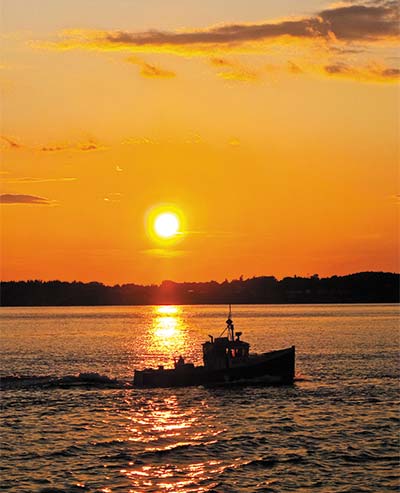
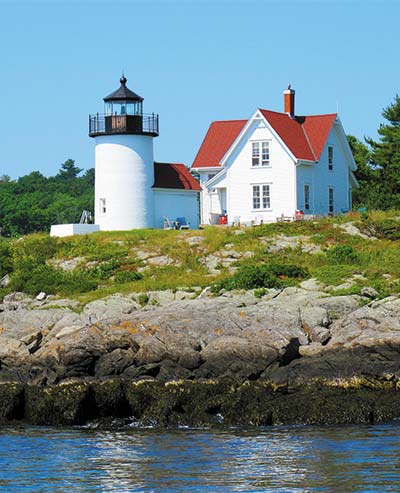
 |
 |
Lighthouses, Lobster, and L. L. Bean
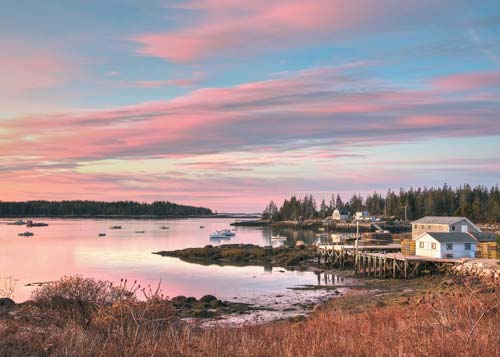
Tipping the northeasternmost corner of the United States and comprising 33,215 square miles, Maine boldly promotes itself as “The Way Life Should Be.” Not to say that everything’s perfect, mind you, but Maine is an extraordinarily special place, where the air is clear, the water is pure, and the traditional traits of honesty, thrift, and ruggedness remain refreshingly appealing.
From the glacier-scoured beaches of the Southern Coast, around spruce-studded islands and Acadia’s granite shores to the craggy cliffs Down East, Maine’s coastline follows a zigzagging route that would measure about 5,500 miles if you stretched it taut. Eons ago, glaciers came crushing down from the north, squeezing Maine’s coastline into a wrinkled landscape with countless bony fingers reaching toward the sea. Each peninsula has its own character, as does each island, each city, and each village.
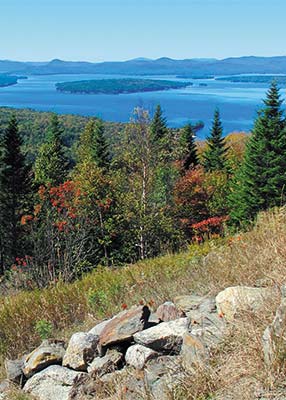 |
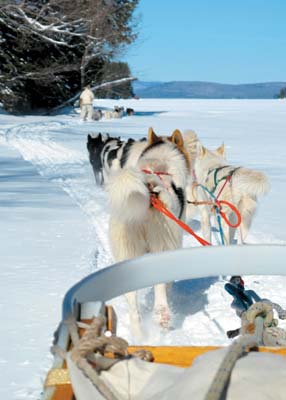 |
But don’t stop at the coast. Venture into Maine’s inland playground: 6,000 lakes and ponds, 32,000 miles of rivers, and 17 million acres of timberlands for hiking and biking, skiing and snowmobiling, paddling and fishing. This is where intrepid Appalachian Trail hikers finish at the summit of Katahdin, Maine’s tallest peak, and determined canoeists can spend a week on the Allagash, a water lifeline through the wilderness.
Pair natural highs with human pleasures: fine and quirky museums, theatrical and musical performances, artisan studios and art galleries, designer boutiques and specialty shops.
Lobster, of course, is king, but don’t overlook luscious wild blueberries, sweet Maine maple syrup, delicious farmstead cheeses, and the homemade pies and preserves sold at roadside stands and farmers markets. Access to this bounty is why talented chefs are drawn here. But balance a fancy meal with a beanhole or chowder suppah, where you can share a table with locals, the umpteenth-generation Mainers who add character to this special place: the fishermen who make their living from the bone-chilling waters, the lumbermen who know every nook and cranny of the forested wilderness, the farmers who tame the rocky fields. If you’re lucky, you might hear a genuine Maine accent (hint: Ayuh isn’t so much a word as a sharp two-part intake of breath).
A student of Maine-born author Mary Ellen Chase once mused, “Maine is different from all other states, isn’t it? I suppose that’s because God never quite finished it.” Maine may indeed be a work in progress, but it’s a masterwork.
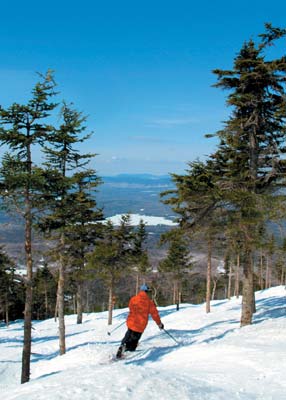 |
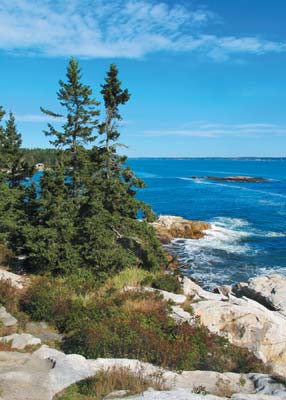 |
Sandy beaches, occasionally punctuated by rocky headlands, are the jewels of the Southern Coast, but this region also oozes history. Colonial roots are preserved in historical buildings while the arts legacy is preserved in museums and galleries. Route 1’s endless shopping opportunities provide plenty of distraction.
Brine-scented air, cackling gulls, lobster boats, and fishing trawlers give notice that this is a seafaring town, but it’s also Maine’s cultural center, rich in museums and performing-arts centers, and earns national kudos as a culinary destination.
No region of Maine has more lobster shacks or as rich a maritime history as this peninsula-rich stretch of coastline, dotted with traditional fishing villages and once-thriving ports and shipbuilding centers. The Maine Maritime Museum preserves that heritage; Bath Iron Works continues it; and the brick townscapes, renovated mills, and plentiful shops brimming with maritime treasure keep it alive.
Island-studded Penobscot Bay is the Maine coast in microcosm. Boat-filled harbors, sandy pocket beaches, soaring spruce trees, and lighthouses pepper the shoreline. Gentrifying fishing villages neighbor cosmopolitan towns. Antiques shops, art galleries, artisans’ studios, and museums are as plentiful as lobster boats.
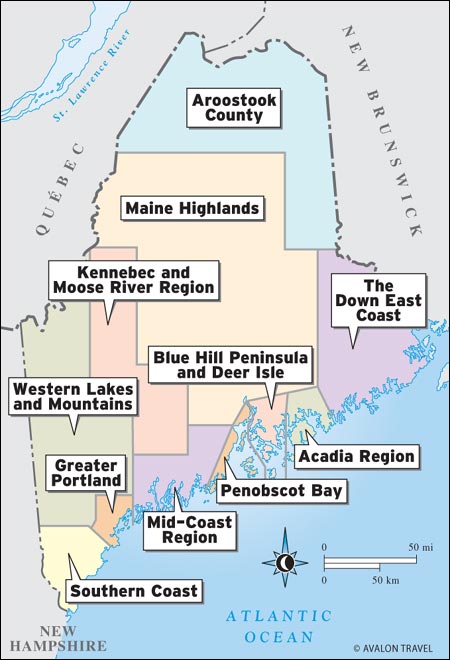
Water, water everywhere. Around nearly every bend is a river or stream, a cove, a boat-filled harbor, or a serene pond. This inspired and inspiring landscape hosts historic homes and forts, classic fishing villages, and a remote section of Acadia National Park. Locals, a blend of summer rusticators, genteel retirees, artists, and back-to-the-landers, have worked diligently to preserve not only the landscape but also the heritage.
Mountains tumbling to the sea, ocean waves crashing upon granite ledges, serene lakes, and soaring cliffs—Acadia has it all. Watch the sun rise out of the Atlantic from Cadillac Mountain’s summit, mosey along the iconic Park Loop Road, pedal the famed carriage roads, and paddle coastal nooks and crannies. Intimate yet expansive, Acadia is as accessible or as remote as you desire.
Here the pace slows, traffic subsides, and traffic lights all but disappear. Blueberry barrens color the landscape; huge tides rule daily life. Two national wildlife reserves and numerous preserves lure hikers and bird-watchers, but the main attraction is the rugged and wild coastline.
Vast, rural, undeveloped, this is Maine’s original melting pot, home to Acadian heritage sites, Maine’s Swedish Colony, and Amish settlements. Remnants of the bloodless Aroostook War with Canada dot the border. In winter, world-class trails and training centers lure cross-country skiers, and 1,600 miles of groomed snowmobile trails connect to an international network.
The Highlands are home to Baxter State Park, with miles of hiking trails, including those on mile-high Katahdin, the official terminus of the Appalachian Trail; the Allagash Wilderness Waterway, a paddling route through the wilderness; the Penobscot River, a favorite for white-water fans and anglers; and Moosehead Lake, where you can cruise in historical fashion aboard the Kate.
“Benedict Arnold Slept Here” signs are posted all along the Old Canada Road National Scenic Byway, which follows his famous march on Québec. In Augusta, the Maine State Museum is an excellent introduction to the state, and Old Fort Western is the nation’s oldest stockade fort. Of course, a white-water rafting trip down the Kennebec is a must.
Generations of campers have favored the lakes pocketed in the mountains of western Maine. Cruise Long Lake on the Songo River Queen II, cast a line in the Rangeley Lakes, hike through Grafton Notch State Park, or spend a leisurely afternoon splashing in Sebago and you’ll understand why. In winter, major alpine resorts keep things hopping.
Late May-mid-October is prime season, with July and August, the warmest months, the busiest. Of course, that means peak-season rates, congested roads, and difficulty getting reservations. Late June and late August tend to be a bit quieter, and everything is still in full swing. Prices and hours or operation throughout this book are for peak season. In the off-season, prices can drop dramatically and operating hours are much more limited. It’s not uncommon for a restaurant to close early on a quiet night. In general, days and hours of operation are subject to change, so it’s a good idea to call ahead or make a reservation.
September-mid-October is arguably the best season to travel in Maine. Days are warm and mostly dry, nights are cool, fog is rare, the bugs are gone, and the crowds are few. Foliage is turning by early October, usually reaching its peak by mid-month.
In winter, especially inland, skiing, snowshoeing, and ice-skating replace hiking, biking, and boating. On the coast, choices in lodging, dining, and activities are fewer, but rates are generally far lower. In areas with solid year-round populations, life goes on full tilt.
It’s a tough job to single out Maine’s sightseeing icons. It offers so many. Unless you have years to spend, such a big chunk of real estate needs some whittling to be made explorable. This itinerary exposes you to a good part of Maine while taking in many of the state’s icons in 20 days.
The downside: You’ll be doing a fair bit of driving, primarily on two-lane roads where speeds through towns are often 25 mph or lower, and during the season when road construction is a fact of life. While this itinerary is planned as 20 days, if your schedule permits, you’ll be rewarded if you spend longer in any of the locations.
Book your first two nights’ lodging in Portland, then book nights 3 and 4 in Rockland or vicinity; 5 and 6 on Mount Desert Island; 7 and 8 in the Millinocket area; 9 and 10 in the Moosehead region; 11 and 12 in The Forks; 13 and 14 in Rangeley; 15 and 16 in Bethel; and 17-19 in the Sebago area.
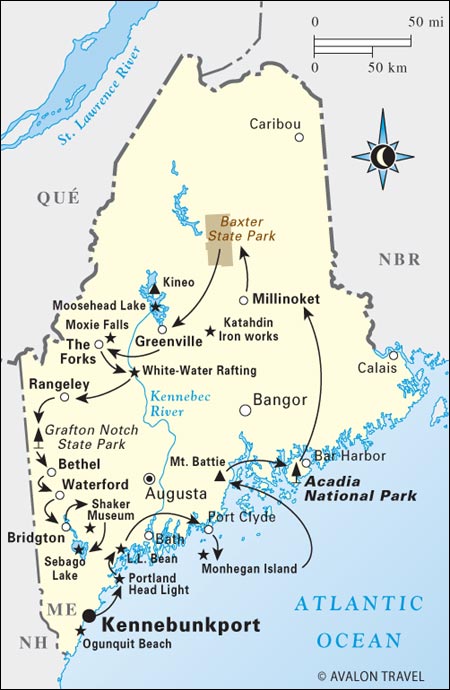
Stretch your legs after your journey to Maine with a refreshing walk on Ogunquit Beach, one of Maine’s prettiest and proof that there’s plenty of sand along Maine’s fabled rockbound coast. Afterward, head to Kennebunkport and indulge your passions: shopping in the boutiques and galleries that crowd Dock Square, taking a walking tour to view the historic homes, or enjoying a leisurely drive along the waterfront.
Begin the day with a visit to Portland Head Light, a Cape Elizabeth landmark and Maine’s oldest lighthouse (1791) at the edge of 94-acre Fort Williams Park. Spend the afternoon in the Portland Museum of Art, Maine’s premier art museum, smack in the heart of the state’s largest city. End the day with a sunset cruise on Casco Bay.
Make a pilgrimage to giant sports retailer and outfitter L. L. Bean, hub of the hubbub in Freeport’s outlet bonanza. Either spend the morning shopping or taking a Walk-on Adventure class. In the afternoon, visit the Maine Maritime Museum in Bath, 10 acres of indoor and outdoor exhibits celebrating the state’s nautical heritage.
Take a day trip to Monhegan Island from Port Clyde. This car-free, carefree gem, about a dozen miles off the coast, is laced with hiking trails and has earned a place in art history books as the Artists’ Island.
Drive or hike to the top of Mount Battie, in Camden Hills State Park on the northern fringe of Camden. The vistas are magnificent, with the broad sweep of Penobscot Bay for a backdrop. Then continue up the coast to Mount Desert Island and begin your explorations of Acadia National Park. If you’ve arrived on the island before noon, pick up a picnic lunch and then drive the Park Loop Road, a perfect introduction to Acadia that covers many of the highlights.
Welcome the day by watching the sunrise from the summit of Cadillac Mountain. Afterward, if you haven’t either driven or bicycled the Park Loop, do so. If you have, then explore the park: Go hiking, bicycling, or sea kayaking, take a carriage ride, or book an excursion boat to Islesford or for whale-watching.
Depart Mount Desert Island and head inland to Millinocket, perhaps detouring to see Katahdin Iron Works but arriving in time for a late-afternoon moose safari.
Venture into Baxter State Park for a day of hiking or rent a canoe and paddle one of the many lakes and rivers.
Drive across the Golden Road to Greenville and Moosehead Lake. If time permits, continue to Rockwood and take the shuttle over to Kineo for a hike.
Take a cruise on the Kate and prowl around the area, perhaps driving to Pittston Farm or hiking.
Drive to The Forks via the Moosehead Scenic Byway and Old Canada Road National Scenic Byway and stretch your legs on a hike into Moxie Falls.
Go white-water rafting on the Kennebec River.
Take the scenic drive to Rangeley via Route 16, keeping an eye out for moose along the way. Work out the driving kinks with either an afternoon paddle or a hike.
Visit the Rangeley Outdoor Sporting Heritage Museum and then take a lazy—or not—afternoon: Hike, swim, paddle, explore, or simply sit and enjoy the environment.
Head south on Route 17 over Height of Land, perhaps stopping in Coos Canyon to try your hand at panning for gold. Continue to Grafton Notch State Park.
Prowl around Bethel’s historic district and explore the Mahoosuc section of the White Mountains.
Snake southward through the White Mountain foothills, perhaps exploring Paris Hill, Norway, or Waterford.
Poke around Bridgton and Naples, and perhaps take a cruise on the Songo River Queen II.
Visit the Shaker Museum, the world’s last inhabited Shaker colony, and tour Poland Spring; there’s a lot more here than bottled water.
Head home after a dip in Sebago Lake.
Maine’s biggest draws are the three L’s: lighthouses, lobster, and L. L. Bean. Maine’s 64 lighthouses stretch from York’s Nubble to candy-striped West Quoddy Head in Lubec. Lobster, of course, can be found practically everywhere along the coast, but the best way to enjoy it is at a no-fuss lobster shack. L. L. Bean’s ever-expanding campus in Freeport is the massive outdoor retailer’s mother ship, but it also has an outlet in Ellsworth.
This six-day tour concentrates on the Greater Portland, Mid-Coast, and Penobscot Bay regions. Book your first night’s lodging in Portland, the second two in Damariscotta or Newcastle, and the next two in the Thomaston-Rockland area. For a real lighthouse immersion, consider splurging on an extra two nights on Isle au Haut. If you’re arriving by air, use Portland International Jetport.
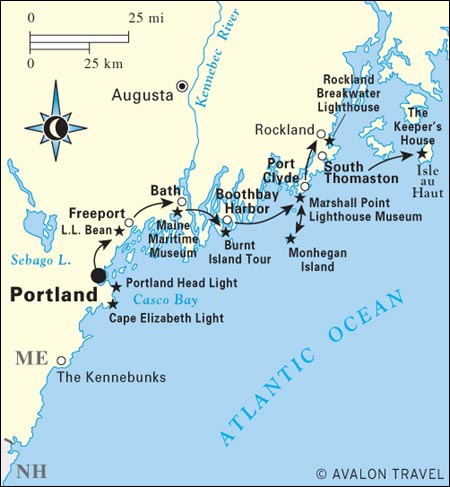
Try to arrive in Portland in time to enjoy an afternoon cruise with Lucky Catch Lobster Tours; perhaps you’ll catch your dinner. If not, you can still enjoy a lobster on the waterfront.
Loop out to South Portland and Cape Elizabeth to visit Spring Point Ledge Light and Portland Head Light, a Maine icon. You won’t find a better setting for lunch than The Lobster Shack, with views of crashing surf and Cape Elizabeth Light. In the afternoon, consider visiting the Portland Museum of Art to view masterworks by Maine-related artists or book a sail amid the islands of Casco Bay. Still craving lobster? Try an inspired version by one of Maine’s nationally recognized chefs (reservations required).
Get an early start and begin at famed outlet store L. L. Bean in Freeport. You might even take a Walk-on Adventure with Bean’s Outdoor Discovery School. In the afternoon, visit the Maine Maritime Museum in Bath, and if time permits, take a lighthouse cruise on the Kennebec River. Perhaps mosey down to Georgetown for dinner at Five Islands or stop in Wiscasset for a lobster roll.
Spend the morning in Boothbay Harbor, stepping back in time for a visit with light keeper Joseph Muise and his family on a Burnt Island Tour. In the late afternoon, drive down to Pemaquid Point to view Pemaquid Point Lighthouse, perhaps climbing to the top. Be sure to visit the Fisherman’s Museum in the keeper’s house. End the day with lobster in the rough in Round Pond.
Begin the day with a visit to Marshall Point Lighthouse Museum in Port Clyde, and then board the mail boat to Monhegan Island. Be sure to visit the museum in the lighthouse keeper’s house. Lunch? Lobster at Fish House Fish, of course.
Greet the day with a sunrise walk out on the breakwater to Rockland Breakwater Lighthouse. Afterward, tour the Maine Lighthouse Museum and Farnsworth Art Museum. In the afternoon, take a lighthouse-themed cruise or sea kayak tour out of Rockport or Rockland. End the day and your lobster-infused vacation at the James Beard Award-winning lobster shack Waterman’s Beach Lobster in South Thomaston. En route, take the short side jaunt out to Owls Head Light in Owls Head.
Splurge with a two-night stay at The Keeper’s House on Isle au Haut. The rustic accommodations are in the keeper’s house, oil house, and woodshed at Robinson Point Light, and access is via a passenger ferry.
You’ve been there, done that, and seen all the icons. If you have a sense of adventure, poke around some of the state’s nooks and crannies.
Few visitors make it to Aroostook County, and that’s a pity, because it is a rural gem with great outdoor resources, including Aroostook State Park and rich Acadian and Swedish heritage sites. Because of the sheer immensity of the county, you’ll want to plan at least four days to a full week.
Be sure to explore the back roads for big views and surprises. Along Route 2 between Sherman Mills and Houlton are Golden Ridge with panoramic views, a railroad museum, and an Amish colony. Route 164 loops out to the Salmon Brook Historical Society and Woodland Bog Preserve. And tucked just off Route 161 is Maine’s Swedish Colony.
Few folks travel northeast of the Acadia region, but those who do are rewarded with a more authentic Maine experience. From Milbridge through Calais, the Maine Coast has a much different feel than points south. Fishing villages have yet to be gussied up or gentrified, and harbors are filled with working boats, not yachts. Museums, such as the Burnham Tavern in Machias, the Ruggles House in Columbia Falls, and the Tides Institute and Museum of Art in Eastport, are small in size but deep in local heritage. Bring a passport, and Campobello Island International Park is yours too.
Coastal hiking trails and wildlife preserves attract birders, and if you continue inland to Grand Lake Stream, you’ll stumble upon an anglers’ paradise.
There’s no finer way to experience Maine’s forested wilderness than to immerse yourself in it at a traditional sporting camp. Created more than a century ago to cater to the needs of hunters and anglers, today most are wonderful family destinations during the summer. You can hike, fish, paddle, swim, search for moose or other wildlife, or simply relax and enjoy the away-from-it-all experience.
Sporting camps dot Maine’s North Country, with concentrations around the Rangeley Lakes and along the waterways surrounding Baxter State Park and Moosehead Lake.
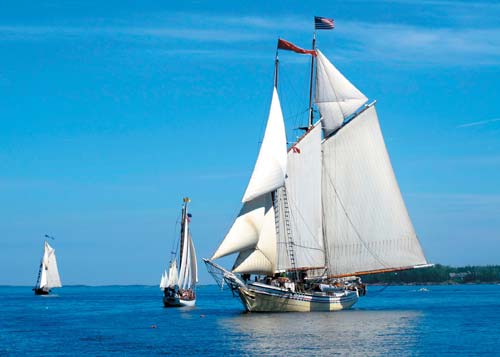 |
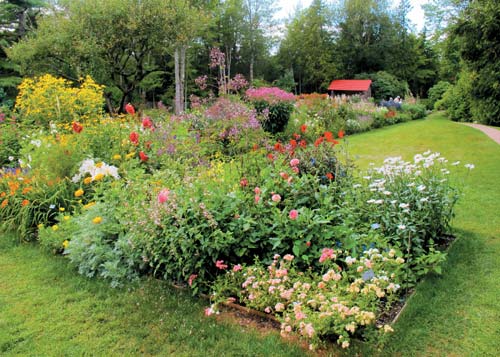 |